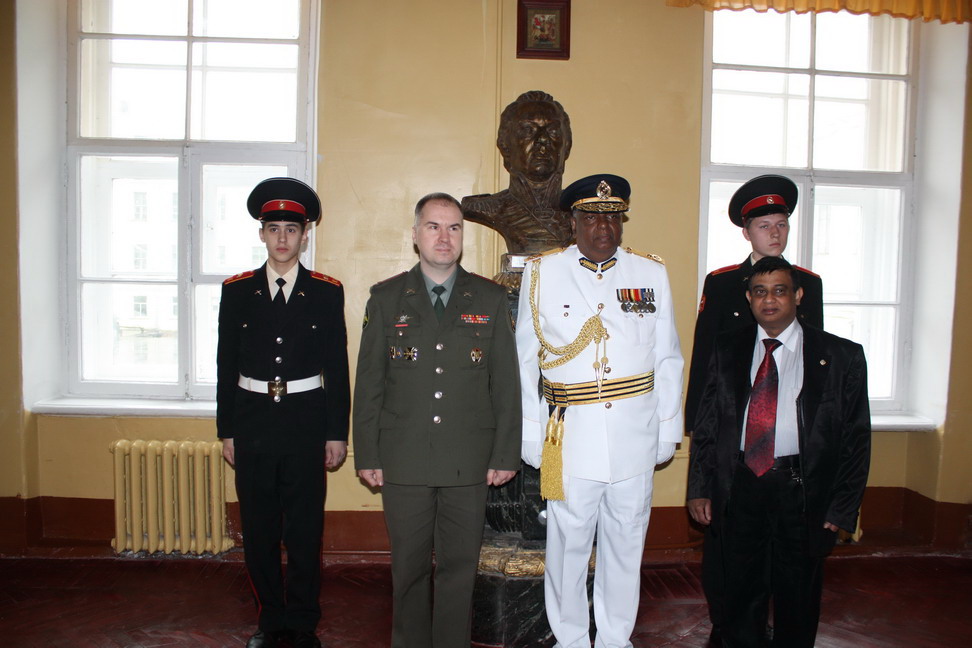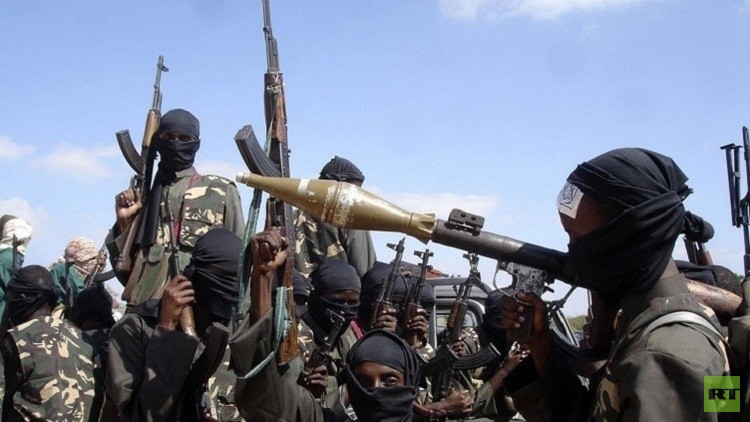
PROF. MAHINDA BALASURIYA
Grand Ph.D., (IUFS Russia), M.Phil., (Sri Lanka), B.Sc., (India)
INSPECTOR GENERAL OF POLICE (CHIEF OF POLICE)
SRI LANKA
“For a People who are free and who mean to remain so, a well organized and armed militia is their best security”
–Thomas Jefferson–
Introduction
The conflicts among the Nations and within the Nations are common as the inception of the mankind. Although the historical factors are varied, time to time, the destruction caused by the conflicts created a dilemma on basic needs of the humans, specially its security. The art of defending them –self evolved the new concepts of National Security. The dimension and the magnitude of National Security were subjected to redefine, over the socio economic factors, cultural and religious issues and the newly created concept of “Globalism”, in the recent past. This research paper is on the manner and the degree of the elements of multi ethnicity which affected the concept of National Security, with special references to conflict in Sri Lanka caused due to multi ethnic atrocities.
Part (I) Nations and the Security
- State, Nations, Government, People and National Security
The expression “National Security” comprises the terms “Nation” and “Security”. Security is the primary human need. It is by origin, where the amplifying adjective, national is comparatively modern; its evolution can be charted from the treaty of Westphalia through the French Revolution to the present day. There are signs that it will further transform. The term national security was not widely used till World War II. It was by and large associated with military security. Even today, there is a reluctance to dissociate it from this belief system. It is conditioned by centuries old warring traditions.
Ordinarily National security means the safeguarding of the territorial and sovereign independence and identity of a state from invasion, occupation and acquisition by a foreign power. It also means the protection of the government in power against internal subversion and insurrection, seeking to overthrow it by unlawful means. An insurrection could therefore be a serious security threat to a government specially because it may be engineered and supported by a foreign power with a view to destabilizing or gaining a foothold. Either way these are very grave security threats to a state which should therefore concern itself with them and take appropriate measures to prevent them or deal with them should they materialize.
A sovereign state is therefore obliged to think about security as a matter of self preservation however much it may find the idea morally distasteful, as a kind of thinking evil of others. At the same time it is not unusual for state to talk openly about it, make frequent pronouncements or disclose its ideas. Such statements may it at all be made on specific occasions like a declaration of war, a cessation of hostilities, a commemoration of such events when it is customary to invoke patriotic feelings or affirm determination. Allusions may be made on such occasions to the wider objectives of security which would transcend pure territorial integrity and extend to spiritual beliefs, cultural heritage, national personality and other dimensions. Security from these angles would be perceived as the preservation of a certain way of life of a society, a distinctive personality which may be referred to in popular language as a nation or people. However such attempts to spell out the connotation of security may occur mainly at moments of stress or under emotional strain because ordinarily it would suffice to refer to the need for security as a corollary to independence and sovereignty.
The role of the state in terms of the national security had been discussed by the Supreme Court in India. The Indian Supreme Court ruled that the Government had failed a licit promise, cannot claim impunity on doctrine of promissory estoppels, and is bound by consideration of honesty and good faith. On the contrary, the government should be held at a high degree of rectangular rectitude while dealing with the citizens. The role of the state is flashed in this ruling. All these are auditions in various social structures, ancient or modern. National Security is not an end by itself, It is an approach goal. If that is the way it has to be seen, the role of the state irrespective of its basic structure is to go for it by measures that indicate the process status. This is done by defending the state, providing law and order, producing goods and services, regulating the system and supplying “Public goods” such as education, health, infrastructure, drinking water, etc.,. In this role, the state has to understand that national security is a movement, not an end goal, and needs the participation of the citizens as the end beneficiaries. The lingering question is, “who is responsible for national security?” The answer may be subjective in most cases. In a country obviously the accountability is with the government. People’s participation is the next interest. It is very much so in democratic countries because it is peoples rule. People also include the opposition. In protectorates, etc. People are only subjects; the accountability is with the protecting government rather than the people who largely play a supportive role.
- General Concepts of National Security
Security is a matter of concern for human beings. It is a concept that changes with respect to the changes in evolution around a basic core that remains relatively invariant. Security is no more the physical security in the absence of claws, jaws and size. The security concept is based on the aspirations of the people relative to the groups they belong to. The aspirations can be inflated; most of the time they are. When not achieved, people rely on spiritual security activities concomitantly. The human race moves forward in this churning globule contented with self-rationalization.
The aspect of security of an individual within a formal group is converted into national security subsequent to the formation of nation-states. The name is new, but the concept is old. The identity of human beings today is associated with their countries. The state and its Government are accountable for providing them the minimum required security- the apparent security.
Security of its people is the responsibility of the state. Adam Smith (1723 – 1790) conceived the role of the state in “atomic capitalism” in which every individual is considered to be the best judge of welfare. Social welfare was the sum total of the welfare of the individuals. According to Adam Smith the functions of the state are:
- Defending from external aggression
- Maintenance of Law and Order
- Enforcement of sanctity of contract entered between different individuals for commercial transaction.
- Providing infrastructure, education and assistance to the poor.
Adam Smith theory was based on highly atomic capitalism and was treated as one of state minimalism. In a socialistic approach, privatization was abolished in order to remove inequality between the haves and the have-nots. The state was given the role of acting as a vanguard of the people in a social order based on equality.
Joseph J. Romm, in his book Defining National Security traces the modern etymology of the phrase to the United States bearing in August 1945. He quotes, the navy Secretary James Forestall stating that national security could be assured on a very broad and comprehensive front. Forestall added that the word security, was emphasized consistently and continuously rather than the word, defence. Senator Edwin Johnson in his reply confirmed his appreciation for the terminology, national security. The emphasis here is on words used in plural, not definition. The term comprising the words was not merely a question of the army and the navy, but comprised the whole potential for war, mining, industry, manpower research and all the activities that went into normal civilian life.
The race of nations to attain power is motivated by the survival instinct to influence global events in one’s favor. It is inherent in group behavior. Barring military strength, balanced elements of power will be used for this by each nation in different ways. For some, it will be by ethnic methods and religious beliefs. For others, it will be by accrual of strength through internal and external quality acquisition: a healthy and competitive economy, leading edge technology, viable industrial capacity, quality education, international efforts through diplomacy, etc., They will prefer a lean and lethal military to protect national interests,. More; ideas may follow as humans keep evolving. National Security as a concept dictates decisions in the international arena. The emerging international system today is Independent of aspect that limits the freedom of action of states. This is the setting in which nation-states shall ensure their security by maintaining national interests.
One of the first texts in international studies to argue comprehensively for this wider view of security was” Barry Buzan’s ” People, States and Fear.
Individual security seems to be important for Buzan principally in that it provides a basis for national security. Freedom for one individual, may be an actual or potential threat to the security of others, and the problem is how to balance freedom and security. The state is justified as an instrument for achieving this balance, and thus national security can be seen, to some extent, as individual security: ‘The security of individuals is inseparably entangled with that of the state.’ (p 39) ‘State and society become increasingly indistinguishable,’ adds Buzan (p 39), Buzan,believes that the National Security is more tied to Military power. He lists 05 major factors as Military, political, economic, societal and environmental. Further, he emphasis a state-centered concept backed by military.
Some Thoughts of the Concepts of the Security:
According to a report submitted by an expert group of the United Nations, which was adopted by the United Nations General Assembly, perpetrated the idea that;
“In principle security is a condition in which states consider that there is no danger of military attack, political pressure of economic coercion so that they are able to pursue freely their own development and progress”.
In 1965 early writers such as Berkwitze and Bock had described national security as follows (Mahinda Werake and P.V. Jayasekara. 1995, p.5)
“National Security can be most fruitfully defined as the ability of a nation to protect its internal values from external threats”.
Cohen and Tuttle have defined as a protective condition which statesmen either try to acquire, or preserve, in order to guard the various components of their politics from external or internal threats “.
- Analysis of the Dimensions of Elements – National Security
An element is the fundamental part of a concept. A concept may comprise one or more elements. National security is one such concept. It is multi elemental. Elements are threat attractors. Threats derive from various factors. A threat to the elements cannot be observed easily since it is symptomatic. The symptoms are those that lead the attention of a strategist towards the concerned elements of national security indicating flaws in its governance and management. Therefore, the capability for proper diagnostics is vital in identifying and analyzing elements of national security
Characteristics of Elements
While identifying the elements of national security, all factors that are commonly linked with the concept and satisfy specific characteristics were considered:
- Directly influence human life – as a system entity within itsown boundaries.
- Fundamental whole of the concept – definable and appreciable within a system boundary.
- Independent threat attractor – continuously under threat.
- Periodic in origin – appeared in different periods of time in the evolution of the concept.
- Continuous and uninterrupted since origin – the element should be ongoing; an element interrupted in between will be a new element when it re-enters the chain.
- Independent variable with a profile – so that the indicators of the elements can be ranged on a minimum-maximum scale.
- Interactive with other elements – mutually interactive and well interfaced; with each other for effective integration in the national security matrix.
- In vogue in its usage in national security – should be known and easily comprehensible to the people, not just a select few.
- Macro level social impact – national security is viewed at macro level and therefore, the element should be acceptable at the same level.
- Terrain specific – the element should be identifiable with one or more terrains.
- Can maximize national security – governance friendly with the capability to maximize national security.
- Universal in character – national security being a universal concept its elements should have the same appeal.
An element has to be an integral part of national security tested for the appreciated characteristics. The effect within an element directly impacts national security, whereas, a condition or a threat impacts an element. There are many situational factors widely in use in assessing national security that can be misrepresented the elements. Considerable effort and money goes into managing them as elements by wrong diagnostics.
Elements
Prabhakaran Paleri in his publication (IMPERATIVES AND CHALLENGES – NATIONAL SECURITY) identifies the under mentioned as the elements of National Security.
- Military security
- Economic Security
- Resource security
- Border security
- Demographic security
- Disaster security
- Energy security
- Geostrategic Security
- Informational security
- Food security
- Health security
- Ethnic Security
- Environmental security
- Cyber security
- Genomic Security.
However, this could be varied or re-defined under different dimension such as multi ethnics, multi religious or different form of governance in different terrines.
In the culmination after an in-depth analysis it is clearly viewed that national security is an inseparable factor of human life, citizens of countries and also a imperative social economical need.
Thus:
- National security is a realistic concept that relates to safety, security and psychological aspirations of the people of a nation concerning their well- being in accordance with their needs and, therefore, has to be universally common to all.
- Hence, national security is a definable entity. The definition has to be arrived at by closely examining the existing definitions and the evolution of the concept from the earliest known time.
- Once defined, it could be measurable with respect to time and capable of modeling.
- Humans were concerned about their safety and security since the beginning, it is the same security principles coupled with the understanding of human aspirations that are to be considered within the framework of a nation.
- National Security comprises various elements that are to be identified with the parameters integral to its evolution.
- Thus, indicates that there could be elements that were prominent in the past and lost importance subsequently and also a chance for new elements to come up in the future.
- If national security is about the well being of people, then the objective is to maximize the well-being.
Part (II) Perception of National Security
Trends in Multiple Ethnicities – Ethnic Security View Point.
Human beings live in divided societies and alienated mental communes. While such ethnicity may have its violent overtures, it is the simmering discontent of the divided human that invokes national security concerns. Ethnicity in national security studies springs up from all that contributes to the human divide communal, cultural, national, religious, tribal, caste, racial, gender, origin, age, based issues etc.,. – That threatens the integrity of a nation. Such a definition also avoids ambiguity with respect to other known principles of ethnicity quoted in different contexts. For example, in the Genocide Convention and in general lexicography, ethnic groups are considered to be different from three other groups – national, social and religious. In this paper the term “ethnicity” means the all. Encompassing terminology that marks the difference between individuals and thereby, groups in every order of difference that divides one human from another. The dead-end of the road in an ethnic conflict is the probable break up of the nation-state. At the lower side it is just restlessness and loss of productive ambience in the psyche of a state. Communal issues that originated from ethnicity could also be seen as part of larger agenda of fundamentalisation of the world.
There is the age-old belief that shared values and security strategies can reduce ethnic conflicts. Ethnic problems can be caused by demographic dynamics and formulation and belief systems. Tolerance, education, communal harmony and integration of minority groups are voiced remedies. Early warning systems may give time for preparation, the most important ingredient in the ethnic security action plan in case methods of integration fail to yield result. The problem becomes serious when ethnic groups lose touch with global values. Education is a solution, but conditioned ethnic gangs cannot be controlled by mere education alone. Ethno-nationalism, fundamentalism, militant secessionism, militarism, territorial dispute, national chauvinism, economic deprivation and gender-biased insecurity are all factors that affect ethnic security.
Ethnic Security is about every aspect of differences and subsequent changes in interactive behavior in which one of the parties feels low and engaged. It could even happen within a sub –system – an organization, sports field, educational institutions, military etc. Ethnicity covers differences in human attributes based on many factors:
- Culture – Hinduism, Judaism, Shinto’s, etc.
- Religion – Buddhism, Christianity, Islam, Sikhism, etc.,
- Cast – High cast and Low cast
- Sects – Sections within the Religions
- Colour – Black, Brown, White, yellow
- Race – Caucasoid, Negroid, Mongoloid, Australoid etc.,.
- Language – English, Chinese, Hindi, Tamil, Sinhalese etc.
- Nativity – Indigenous, non-indigenous, immigrant, settler, non-resident, etc.,
- Age – yound, Old, teen, etc.
- Gender – Male, Female
- Sexual – bisexual, heterosexual, homosexual, castrated, asecual, etc.,
- Education – Literate, illiterate, educated, intellectuals etc.
- Money – rich, superrich, poor, below poverty line etc.,
- Accent – Southerners, Biharis, cowboys, Yankees, etc.
- Position – royalty, bureaucrat, politician, commoner, etc.
- Statues – very important, important, commoner, persona non grata, etc.,.
- Occupation – Minister, bureaucrate, military clérical, etc.
- Service – Government, Private, self employed, housekeeping etc.,
Part (III) Effects of Multi Ethnicity in changing the Dimension of National Security
Characteristic of Multi Ethnicity
- Special Characteristics
Apart from the characteristic had been discussed earlier a group of special characteristics could be observed in the multi ethnic cultures where prolong conflict of ideology prevail. Example could be quoted from Sri Lanka and middle-east in this context. The communal disharmony back with suspicion of the other communities and rapidly changing attitude are the route causes for these special features. Thus, the writer identifies the following features as essential component of the security in multi ethnic dimensions.
- Personal Security
- Military security
- Communal security
- Cultural security
- Political Security
- Law and order security
- Regional and Global security
The above is discussed and defined by some academics as the rights of minorities in the multi ethnic’s multi cultural Societies. The concept of freedom of the minority groups are also linked with the rights, as the excising of right derives through the space of freedom. In this notion the security interlinks with the concepts of freedom and in the contrary certain impediments has to be enforced against the freedom, by the state. When the national security is challenged by either majority or the minorities, the foregoing situation also could be interpreted as a leading factor to worsen the ethnic conflict.
Overall the security provided by the military to protect a state from external/internal threats is the key factor when the national security of the country is challenged or at stake. The military security over rides the other elements of security with the change of the security environment and fluctuate proportionately to the degree of either the internal or external threats. This factor had been accepted by the academics and scholars (Thomas Jefferson) and proven in the Sri Lankan context. The inter- linkages of these elements and the co- existence backed by military security as bottom line is shown in the Matrix below :
The Model Depicting the Integration of the Elements of National Security :
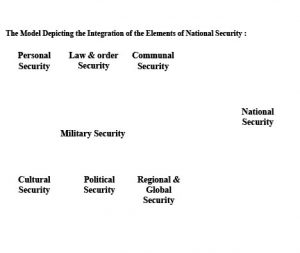
Special features of the Minorities – Strength & Weaknesses
- Power derived from strength
- External & internal forces and degree of threat
- Unity based on culture, religion and values.
- The Dilemma
- Concepts of Minority Rights
Every human being is equal irrespective of its cast, colour, sex, nationality, or any other fundamental features of the human being. (UN Charter) These principals linger over all the instruments of the United Nations and most of the human rights charters and protocols. Further, this factor is enshrined in most of the written and unwritten constitutions exist around the world. In the fundamental right Chapter of the Sri Lankan constitution (1978) also contain similar materials. Hence, the minorities should not be subjected to any of the harassments or indifferent treatments, legally or ideologically. However, as discussed, the majority of the battle, of internal and external conflicts are based on claims of harassments injustice and unequal treatments, waged by either the majority or the minority with or without assistance of the foreign powers. This is conspicuous in middle-east, Ireland, India, former USSR and Sri Lanka.
Apart from internationalizing an internal conflict, an opportunity is granted to a 3rd force to creep into an internal conflict in the guise of protection of minorities. This could be identified as another dimension in multi ethnic conflict. Thus, the concept of sovereignty of states is drastically challenged in the national and international domains, causing external threats to national security.
- Majoritarian Rule
On the contrary the minority ethnics, frequently level allegations of a majoritarian rule either by way of constitutional or legal ways or gross physical means. This is a common allegation in situations where the ideas, notions and requirements are not considered when creating primary and fundamental documents in governance. Specially, in creating one’s homegrown constitution, the absence of the ideas and the rights of minorities clearly set an example to confirm these allegations. If the minority rights are not being confirmed in specific terms, the claims of the minority would be further strengthened. This opens a window of opportunity to ignite the fire ball of the conflict which could be fueled by the ideology and finally turned into a possible armed conflict or an internal war. Sri Lanka is a clear example, subjected to this allegation, as all three constitutions since independence had not been formulated with the consultation of the minorities. (1948 Solbury Constitution, 1972 constitution and 1978 constitution) Thus: paved the way to, 30 years of bloody war act of terror and downsizing the economy of the Country.
- The Conflict
- Initial Reactions in Multi Ethnic Cultures –
Special Emphasis on Agitation and Riots Effecting Internal Security
An ethnic riot is intense and sudden often premeditated and well planned. It is executed under primordial violence. Communal violence, racial attacks, religious wars, linguistic agitations, tribal disturbances, political violence, etc.,. are some of the terminologies used to depict an ethnic riot targeted against one group by another. Often, the attacks are not by accident. The participants believe in their acts firmly. It can be controlled by the state but the state does not normally interfere in the initial stages. According to author Donald I.. Horowitz, a riot causes in casualties. The death toll can range from a few to hundreds of thousands,. The 1947 India – Pakistan partition riots were the worst recorded. It was unparallel to any kind of human movement or exodus in history. The refugees were brutally attacked by disoriented savages of faith of their own genre, violating all norms of civility. Effecting dislocation is the primary purpose of a riot.
The outcome of ethnic violence by private armies, militant leaders and violent political groups may cause additional harm. Such violence will be a cause for separatism, fragmentation and de-stabilization of a country in the long run. Ethnic violence can turn to secessionist wars. The effect of a riot is very discernible. The attackers and targets are known. It is not a casual or spur of the moment affair.
The attacked may try to defend, often without success. Success is decided on the counter attack. It takes place often after a lapse of time. The counter attack is also whipped on to innocent victims identified with the original attackers. The riots go on until the state intervenes with force. There are many cases where the state fails to intervene for reasons of ethnic politics. In such cases, one party gets victimized totally.
What reflects in an ethnic riot is the clear and present antipathy and intolerance in a social system where every human looks at an identity external to him. This is seen in the regularity and striking similarity among riots in the world as a general phenomenon and not exclusive to a particular society. It is a faithful reflection of tenuous human relations and the fragility of existence within which the concept of national security can asphyxiate. Ethnic riots follow made-to-order belief systems the world over. There are many such belief systems
- The government is supportive of the conflict
- Enforcement agencies are either party to it or support it
- The ethnic organizations are supportive of it
- External forces are supporting such riots
- The powers of the world are parties to it
- The superpower is a party to it
- Everything is related to religion
- A new violence will follow after a lapse of time
- Media does not report the truth
- Opportunists in various shapes and forms take advantage of the situation.
- There is no end to such violence in society.
In reality, these belief systems are not the guiding lines in ethnic security management. The dynamics of riots is the organized and structured violence. It is this appreciable structured behavior and dynamics of a riot that make it more amenable to containment by law enforcement forces, provided there is political will. Political will is the key factor of national security.
The Model of The Emerging and Expansion of The Multi Ethnic Sentiments Effecting National Security
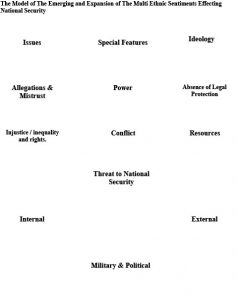
- Source : Developed by the writer
Part (IV) – Managing National Security with Special References to
Sri Lankan Conflict
National Security Management will be under the policy based perception of the governments- political power maximization; holding the position; succession issues, dynastic agenda; political existence and survival; dominance; annexing territories; military power; national power maximization, etc., whereas, the concept is people-centric, aimed at their benefit individually and socially. The agent beneficiary is the people. Therefore, they should effectively participate in management towards national security. Prabhakaran Paleri observes in his book on National Security(P- 396)
- Methodology
Sri Lanka adopted a multi disciplinary approach in settling the ethnic conflict since 1956. Two important pacts had been signed between the majority Sinhalese leaders and the leaders of the minority prior to 1970 (Bandaranayaka – Chelvanayagam pact, Dudly Senanayakaya- Chelvanayagam pact) However the impact of these two pacts were short lived and temporary. The communal feeling of the minorities aroused gradually and it was turned into militancy with the emergency of LTTE 1976.
Upon getting into the stream of violence the LTTE continued with acts of terror by eliminating democratic tamil leader ship and followed the foot step of insurgency and later transformed into guerilla type war fare. The intensity of the act of terror grown over a period of time and finally in year 2003 a major portion of the North & east Provinces, where majority tamil minorities domiciled, had been taken into the control of the LTTE. A de-facto, state was almost established with Air and Naval power.
The Government of Sri Lanka continued its peace process on its own and with the assistance of neighboring India and the other friendly nations over 10 times, but the efforts were futile. The government went up to the extent of introducing constitutional amendments to devolve power, enabling the tamils to establish provincial councils to govern themselves under the supervision of central government. Although the said amendments still in existing the objectives were not fulfilled.
Having exhausted all possible alternatives the government of Sri Lanka decided to resort to military action against the LTTE de-facto regime under the leader ship of President of Sri Lanka, His. Excellency – Mahinda Rajapaksa. This could be considered as the most significant political decision ever taken by a leader of Sri Lanka. This is in total conformity with the theoretical aspects discussed earlier.
The short term and the long term strategies were formulated based on specific intelligence and strategic terrain analysis. The military, special task force, police and intelligence agencies were trained and modified. The competencies and the capabilities were developed to meet the projected threat of the LTTE. The battle commenced in year 2006 and the government forces were able to clear the LTTE held areas as planed and completed the victory over LTTE in May 19th 2009.
- The Model of the Final Combat
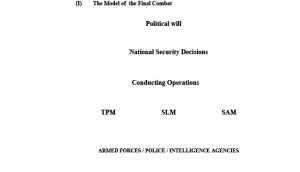
Note : TPM – Threat Perception Mapping
Mapping with respect to threat perception of the state is for tactical designs and short-term strategic appreciation under varying situations. Threat may vary or shirt the location in certain cases. The threat matrix cube explained earlier is an application tool for this purpose. (Prabhakaran Paleri on National Security)
SLM – Strategic Location Mapping
SLM follows PSM. it provides for a fixed long-term planning for operations management in every elemental aspect of national security to the concerned action agencies. It is based on terrain specificity, threat perception, problem dimension and the geopolitical situation against the background of the national security statement. (Prabhakaran Paleri on National Security)
SAM – Strategic Area Mapping
SAM supports median planning to maximize returns from certain specific aspects and minimize damage to them. (Prabhakaran Paleri on National Security )
- Source : Developed by the writer with references (Prabhakaran Paleri on National Security )
- Sustainable Peace – A Win – Win Situation, to meet the Global Challenge.
Irrespective of any theory or approach the expected outcome of the national security is peace and freedom of individuals. During the process one may come across setbacks, pains or losses, life or property, in achieving peace. But the true objective of the national security is to maintain peace and freedom for all, all the time. In simple form the sustainability in prevailing peace. The wounds of the conflicts or the effects of the threats could be erased off if peace sustains after a conflict. The objectives of the both victor and the looser are matted with success if the fruits of the peace is accepted. This could be defined as a win- win situation for both parties. In achieving and maintaining this status- quo, all individuals must accustom themselves into one stream of thinking, adjust their attitude, whilst the government would act with genuineness backed by adequate legal frame work where justice and equity are prevailed
Research Assistants
The following research assistants approved by the IUFS assisted me to prepare this article.
- R.Waidyalankara (M.Sc., LLM, LLB, Attorney-at-Law)
Senior Superintendent of Police
Director / Crimes
Police Headquarters,
Colombo 01
Sri Lanka.
- Mahil Dole
Senior Superintendent of Police
Staff Superintendent to I.G.Police
Police Headquarters,
Colombo 01
Sri Lanka.
Bibliography
- Adams, J., The Next World War, Arrow, London, 1998
- Adler, A., Understanding Human Nature, Research Press New Delhi, 1999
- Blainer, G., A Short History of the World, penguin Books, New Delhi, 2000
- Chairman, Joint Chiefs of Staff, United States of Amercia, joint Pub 1: Joint Warfare of the US Armed Forces, National Defence University Press, Washington DC, 1991
- Chaliand, Gerard, and Jean-Pierre Regeau, The Strategic Atlas: A Comparative of World Powers, Harper Perennial, New York, 1992
- Chomsky, N., Deterring Democracy, Vintage, London, 1992
- Churchill, W.S., The Second World War, Penguin, London, 1992
- Clavel, J., (ed), The Art of War by Sun Tzu, Delta, New York, 1988
- Cleary, T., The Japanese Art of War, Shambala Publications, Boston, 1992
- Cleary, T., The Lost Art of war – Sun Tzu II, Harper, New York, 1996
- Detter, I., The Laws of War, Cambridge University Press, Cambridge, 2000
- Dixit, K.N. Across Borders, Picus Books, New Delhi, 1998
- D.I., The Dedly Ethnic Riot, Oxford University Press New Delhi, 2002
- Huntington, S.P.The clash of Civilization, Penguin Books, New Delhi 1997
- Eric A.., ABC of Peace and Security, Paragon Advertising, Pune, 2001
- World Watch Institute Report on Progress Towards a Sustainable Society, State of theWorld 1993. W.W. Norton and Company, New York, 1993
Articles, Journals and Papers
- Chellaney B. “Valur of Power” “The Hindustan Times, New Delhi, 14 May 1999
- Dixit J.N. “Change and Continuity” The Hindustan Times, New Delhi, 28 April 1999
- Graham, K. “Change the 1945 Balance of Power ” The Indian Express, Mumbai 10 December 1998
- Jensen, R. “A Lost War” The Hindustan Magazine Coimbatore, 19 December 2004
- Johnson, D. “War for Peace” The Asian Age, New Delhi, 7 December 1997
- Material for a study of Marxist theories has been partially assembled by Haupt, 1974 and Yaari, 1978 – 1979
- Anand, V. “Managementof Defence, Towards and Integrated and Joint Vision” Strategic Analysis, Vol XXIV No 11 Institute for Defence studies and Analyses New Delhi, February 2001
- Anand, V. “An Integrated and Joint Approch Towards Defence Intelligence” Strategic Analysis Vol XXIV No. 8 Institute for Defence Studies and Analyses New Delhi, November 2000
- Bhaskar, C.U. ” Trends in Warfare : A Conceptual Overview “Strategic Analysis Vol. XXIV, No. 9 United Service Institution of India, New Delhi, December 2000
- Murthy, P. “India and its Neighbours : The 1990 and beyond “Strategic Analysis Vo. XXIV No. 8 Institute for Defence Studies and Analyses, New Delhi, November 2000
- J. “Dynamics of Limited War”Strategic Analysis, Vol. XXIV, No. 7, Institute for Defence Studies and Analyses, New Delhi, October 2000
- Paleri, P., “An Overview of Military Theories through the Images of War “National Defence University, Washington DC, 1993
- Paleri, P. “National Security Strategy and Bureaucratic Politics “National War College Essay, National Defence University, Washington, DC 1993
- Paleri, P. “The Concept of National Security and a Maritime Model for India” Doctoral disseration Department of Defence and Strategic Studies, University of Madras, Chennai, February 2002.
Websites (www)
- edu/transcrime, (Trans-national Crimes)
- com, (News)
- msn.com (Encylopaedia)
- org.(United Nations)
- org/csi, (UNESCO)
